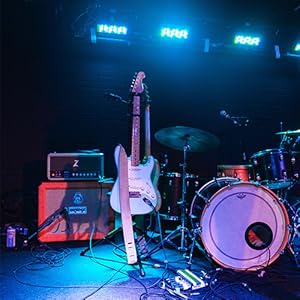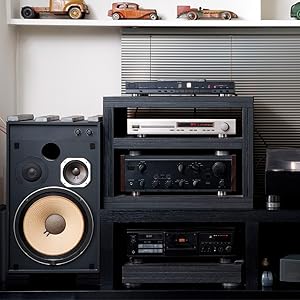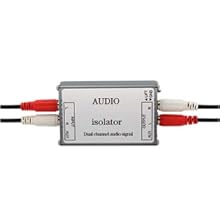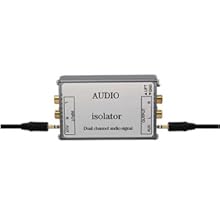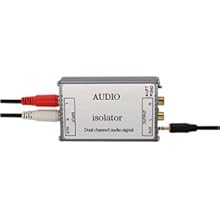Feature
●Hum Eliminator: Say goodbye to noise issues in your car and home audio systems, and enjoy high-fidelity sound output. This product is the perfect solution for tackling stereo noise problems.
●Isolation Transformer: Safeguard your audio devices from potential damage caused by excessive potential difference. This transformer effectively isolates the potential difference between two audio devices, ensuring the protection of input components.
●Superior Performance: Experience exceptional audio fidelity, isolation, and noise elimination with the gold-plated RCA interface and advanced permalloy audio isolator. Enjoy outstanding performance in audio quality.
●Versatile Adaptability: Easily switch between common ground and non-common ground setups with the one-key switch. This product is designed to perfectly adapt to various complex audio and electrical environments.
●Wide Range of Applications: Protect your input components and eliminate ground noise in audio equipment connections. This product is commonly used in car audio systems and home theater setups, making it ideal for a wide range of applications.
Description


When using home or car audio systems, it is inevitable to encounter the buzzing noise known as "electrical noise" coming from the speakers. This noise can greatly affect your user experience and make it unpleasant.
In fact, the "electrical noise" we hear does not refer to a single type of noise, but rather different types of noises with different causes and solutions.
|
|
|
|
|---|---|---|
The first common type of "electrical noise" is the hissing sound coming from the speakers.This "electrical noise", characterized as a hissing sound from speakers, is a common issue referred to as the baseline noise in audio systems. This noise is intrinsically linked to the quality of the audio equipment. High-quality systems typically produce less of this noise, while cheaper, lower-quality systems may emit a more noticeable hissing sound. This baseline noise becomes more pronounced as the volume level increases. As you turn up the volume, the baseline noise also gets amplified, making it more distinct and potentially disruptive to the listening experience. A common misconception about this issue is that it can be mitigated through adjustments to the audio systems settings. However, this is not the case. The baseline noise is inherent to the systems quality, so In dealing with this issue, options are limited. Users can either tolerate the noise or replace the audio system equipment. |
The second common type of "electrical noise" is the unstable noise that fluctuates in volume or occurs intermittently.This noise is mainly caused by electromagnetic interference during signal transmission, which means there is poor shielding. There are two main reasons for this situation. First, it could be due to poor quality signal cables with inadequate shielding density, resulting in interference and noise. In this case, replacing the cables with higher quality ones is required. Second, it could be caused by high-impedance unbalanced signals, such as those from electric guitars or electric basses. When these signals are transmitted over a distance longer than 10 meters, they are prone to interference and noise. To address this, a DI box should be added on the end closer to the signal source to convert the high-impedance unbalanced signal to a low-impedance balanced signal before connecting it to the mixing console. |
The third most common type of "electrical noise" is a strong humming noise known as Hum noise.This noise occurs when the grounding points of two audio devices are not at the same point. Due to the difference in wiring resistance, the noise enters the audio devices through the ground wire, causing interference and noise. We call this common ground noise. This noise often appears in car audio systems, home speakers, radio stations, and recording studios. To solve this problem, you can connect the FMUSER audio ground isolation device between the audio devices. The principle of the audio ground isolation device is to use an isolation transformer to cut off the direct connection of the ground wire in the audio line, thus avoiding the occurrence of common ground noise. |
The FMUSER audio ground isolation device can only eliminate the noise caused by the common ground of electrical products, and it cannot eliminate other noises such as audio equipment baseline noise or RF interference. We can test whether the noise is caused by common ground noise using the following methods:
- Connect passive headphones to the audio source device. If there is no noise, but there is noise when connecting to the speaker system, it indicates common ground noise. Installing an audio ground isolation device can solve this.
- In car audio systems, if there is noise after starting the car, and the noise gets louder as the throttle increases, it is common ground noise. Installing an audio ground isolation device can solve this.
The sources of audio noise can be quite complex and it can be difficult to pinpoint its origins from a brief description. If you are struggling with noise issues and are unsure of the cause, I would recommend trying out our FMUSER Audio Ground Loop Isolator for testing. This isolator is designed specifically to address common ground noise problems and might be able to help with your issue. If you find that it doesnt work as expected or does not help with your problem, you are welcome to return the product. This will not result in any loss on your part.
Application Case
|
|
|
|
|---|---|---|
Connected between two stereo systems |
Connected between the PC and the audio amplifier |
Connected between the Car DSP Amplifier and the speaker |
Connection Method
|
|
|
|
|
|---|---|---|---|
RCA to RCA |
Aux to Aux |
RCA to Aux |
Aux to RCA |
Specification
| Input impedance range | 6000-10kΩ |
| Output impedance range | 6000-10kΩ |
| Frequency response | 20Hz -20KHz |
| Distort | <0.5dB (ref 1khz 1V rms) |
| Insulation voltage | DC 1000V |
| Insulation resistance | 100MΩ |
| Isolation voltage | AC 0~1500V / 50~60Hz |
